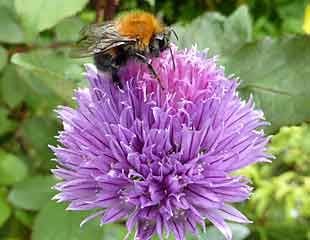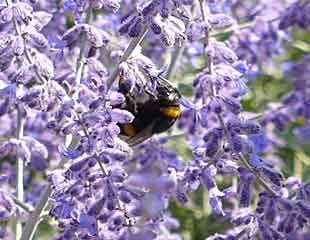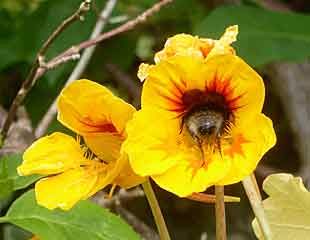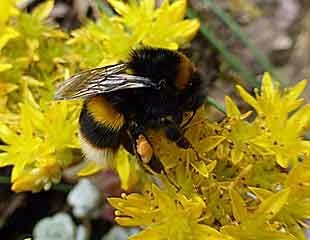|
A few years ago I started planting in earnest to attract bees and now my garden is alive and buzzing. As they say, be careful what you wish for, as I now have bees living in the garden and the eaves of the house. They live quietly and cause no trouble.
So many of the plants are bee friend the garden really does buzz. Top of the best sellers for bees are blue and mauve flowers; Chives, Russian sage and Geranium ibericum are all big hits and covered in bees. The short video “bees love blue” shows this and a moment of garden tranquillity.
Bees also like flowers with a “landing path”, such as Foxgloves, Alstroemeria and Nasturtium; they land and get stuck in, as the images show just bee bottoms.
If you want to encourage bees into the garden, pick a few plants from the Bee friend list, and the bees will follow.
Bees also love herbs and are attracted to Thyme, chives, Borage, Marjoram, Monarda (also known as Bee Balm) and Rosemary. There are plusses all round growing herbs as they taste good to the bees and to us, a herb garden is always buzzing. I often see Tansy recommended for bees, but be warned it is both vigorous and invasive and should only be planted with care.
Not forgetting the Sedum of course, loved by all pollinators including bees and butterflies. In the image the bee has pollen in image the bee has bright yellow pollen sacs.
Bees love the vegetable plot, especially if mixed with the veg are some simple flowers such as Calendula (Pot Marigold) and Nasturtiums. Bees love to pollinate and were whizzing around the broad beans so quickly I couldn’t get a decent photo. This is Broad Bean ‘Oscar’ which I am trying this year billed as shorter and more self-supporting, making it less trouble to tie in and support; so far so good and, as you can see from the image, the flowers are lovely.
Bumble Bees are very important pollinators for tomatoes, and essential part of fruit formation. Commercial tomato growers woke up to the power of bee pollination in the late 1980 and there is now a commercial bumble bee industry. Prior to importing bees into commercial glasshouses tomatoes were pollinated by hand, buzzing the plants to shake the pollen. Studies have also shown the bumble bee does a better job than the human efforts.
I have seen the use of imported bees to pollinate crops, tomatoes, cucumbers and peppers in Iceland where even in the dark winter months, huge glasshouses grow crops. The glasshouses are heated by geothermal energy from the hot springs, efficient and free. Boxes of bees are introduced to ensure pollination.
|








Add a comment: